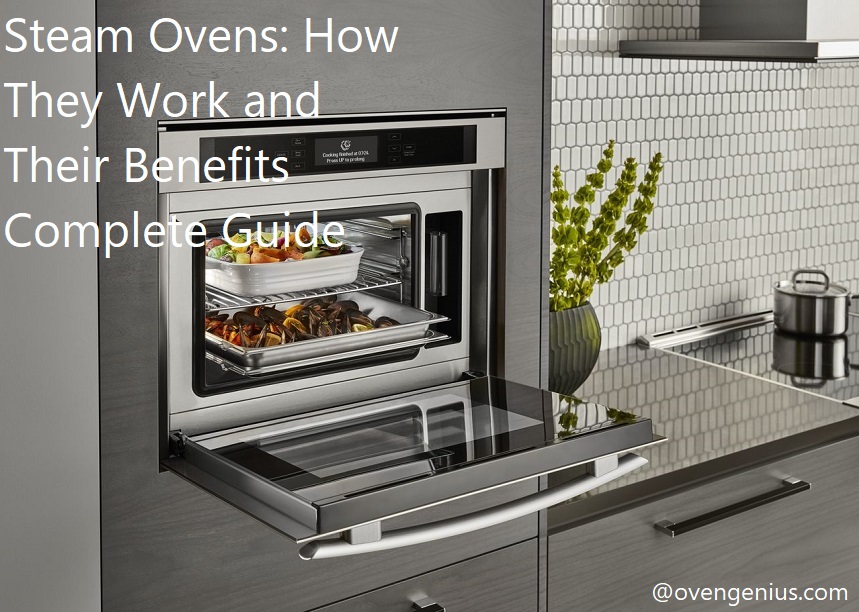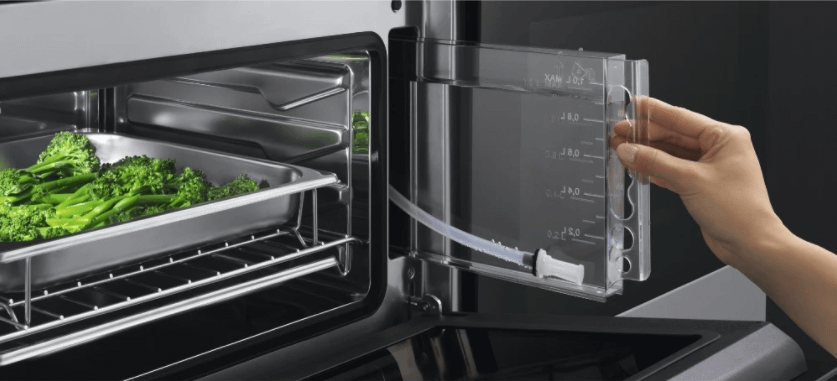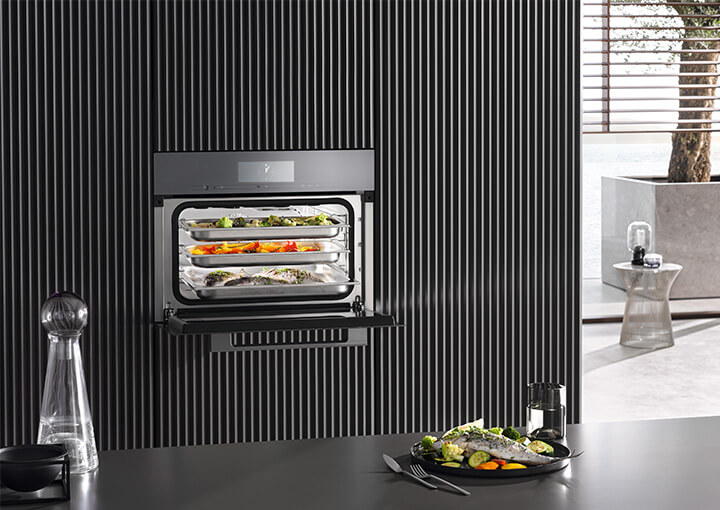Are you looking for a convenient and healthy way to cook? Steam ovens are the answer!
This guide will explain how steam ovens work, their amazing benefits and the different types that are available, so you can make the best decision for you and your family. Ready to learn more? Read on!
Steam ovens are an innovative cooking appliance that uses steam to cook food, as opposed to traditional ovens which use hot air. By injecting moisture into the cooking environment, steam ovens make it possible to cook food with a uniform temperature distribution and much faster than conventional cooking methods.
There are a number of key benefits associated with steam ovens – from healthier meals to improved flavor and texture. In this guide, we’ll provide an overview of how steam ovens work, their key benefits and tips for making the most of your steam oven.
Explanation of steam ovens
Steam ovens are a type of oven gaining in popularity because of their efficiency, health benefits and convenience. In general, steam ovens cook with the power of water vapor, allowing foods to be cooked at lower temperatures than conventional ovens while keeping in moisture and nutrients. In addition, the vapor adds flavor by locking aromas and taste molecules into your food as it cooks.
Whereas traditional methods for preparing meals involve heating a dry air chamber, steam cooking requires water or other liquids to generate steam and then circulate that steam around the food. This method further helps retain flavors, textures, vitamins and minerals otherwise lost when cooking traditionally.
Steam ovens offer a traditional-looking appliance that can be used for multiple types of cooking: baking breads; roasting vegetables; reheating leftovers; making oatmeal; steaming dumplings; blanching vegetables like green beans or asparagus; boiling eggs (hard-boiled or soft boiled); steaming fish fillets and other seafood such as shrimp or crab legs; poaching meat like chicken breasts or pheasant cutlets. They can also serve as a great complement to conventional cooking by allowing you to heat pre-cooked meals faster than a microwave — but with less ‘zing” or loss of flavor potential associated with microwaving.

Importance of steam ovens
Steam ovens provide a number of key benefits. Firstly, and most importantly, food cooked in steam ovens tends to retain significantly more of its water-soluble vitamins and minerals due to the low temperature cooking environment. This means that food retains its natural flavor, as well as its nutritional content, resulting in healthier, tastier dishes.
Furthermore, steam ovens are more energy efficient than traditional ovens due to their modest heat requirements and the differing construction mean the risk of burning or overcooking food is greatly reduced with steam ovens producing consistent results every time.
Finally, steam is an excellent medium for cooking with because it does not allow flavors from different dishes to mix so you can use your steam oven for large batches.
Benefits of steam ovens
Steam ovens offer a wide range of advantages that make them a great addition to any kitchen. Steam cooking preserves more flavor and nutrition, which makes it ideal for healthy eating. Additionally, steam ovens allow you to cook multiple dishes at once without the flavors mingling, making them incredibly convenient. Here are some of the top benefits:
Healthy Eating: Cooking food in a steam oven preserves vitamins, minerals and other nutrients that would normally be lost in other cooking methods. Moreover, because it does not use fat or oil, this type of cooking helps reduce calories and fat content in meals. Furthermore, fruits and vegetables retain their color, as steam ovens cook quickly and at low temperatures which minimize loss of pigment.
Fast Cooking: As the water boils rapidly in the steam oven’s chamber, it produces enough heat to cook food quickly. The moist heat ensures that your food is cooked evenly from top-to-bottom with minimal shrinkage compared to traditional over-browning caused by dry heat methods such as roasting or grilling. This makes it ideal for busy cooks who have limited time but need delicious results every time they turn on their appliance!
Fuss Free Cleanup: As no oil or fat is used during cooking–just plain water–there’s little need for cleaning afterwards! Most dishes can simply be wiped down with a damp cloth – no scrubbing necessary! This convenience alone makes steam ovens something worth considering if you’re looking for a convenient and healthy way to prepare food.
Health benefits
Steam ovens are becoming increasingly popular kitchen appliances due to the variety of healthy meals they can produce without the need for added fat or calories. Recipes and ingredients become healthier when cooked with steam, as moisture seals in vitamins, minerals, and other essential nutrients. Not to mention, dishes cooked with steam retain more of their original flavor because of the even warming that takes place during the steaming process. As a result, people everywhere are adding this health-focused appliance to their homes for making delicious and nutritious meals.
There are two different methods of steaming food – wet-steaming and dry-steaming. Each method has its own advantages when it comes to nutrition:
Wet-Steaming – Food is placed into a colander or steamer basket in a deep dish with just enough water at the bottom of the pot or pan so that it doesn’t touch the food. The moisture from this steaming technique helps vegetables retain up to 15% more nutrients than boiled vegetables have been known to keep.
Dry-Steaming – The steam oven’s unique fan system helps circulate hot air all around your food; this method is especially effective at cooking large pieces of meat thoroughly without having them become overly dry or tough like traditional roasting does. Dry-steamed foods tend to be juicier due to their sealant effect on vitamins, minerals and essential nutrients.
In addition to being able to continuously monitor food as it cooks inside your steam oven due to its glass door window feature, you will find grilling and baking racks in most models that allow for multiple recipes items at once – making meal prep even quicker! Plus cleanup is super easy too – simply wipe down with a damp cloth!
Cooking benefits
Using steam in ovens offers several advantages over traditional dry-heat cooking methods. It helps to preserve nutrients and prevent shrinkage of food, so dishes stay juicier and more flavorful. Time spent in the oven is typically much shorter due to the size of the water droplets, so food is cooked faster and more efficiently at a lower temperature. This results in significant energy savings as well as faster preparation times.
Additionally, steam is less likely to burn food than hot air without affecting its texture or flavor. It even makes sure that delicate items such as desserts can be baked with ease, with minimal risk of them drying out or overcooking. Most modern steam ovens provide even heat distribution around all sides of your dish, ensuring that it cooks evenly for perfect results every time.
Energy efficiency
Steam ovens are incredibly energy efficient, using only about one-third of the energy required to operate a traditional electric wall oven. This is because a steam oven does not require preheating, or for the temperature to be adjusted up or down according to recipes – the hot steam is ready immediately.
As an added bonus, a steam oven can be used in tandem with a traditional electric wall oven without too much extra energy use. Furthermore, since there’s no need for cool down time, food reaches ideal serving temperature more quickly than with conventional roasting and baking methods. This means that your kitchen stays warm and comfortable while cooking – an added benefit in winter months!

Time-saving benefits
When it comes to oven cooking, steam ovens are far more efficient in terms of time savings. It takes much less time to prepare food with this type of oven. This is because the hot air circulates quickly and heats up foods rapidly, allowing you to cook meals in a shorter amount of time compared to conventional ovens. In addition, steam ovens do not require preheating, which further reduces your prep and cooking times. As a result, you can have nutritious meals on the table faster for yourself and your family.
In addition, steam ovens typically offer several preset programs so you can quickly choose settings for different types of dishes that would otherwise take a lot more time with traditional methods such as boiling or roasting. Some models even feature a timer mode which allows you to set cooking times for specific dishes without having to be present in the kitchen throughout the process. This lets you get other things done while your food is prepared conveniently and quickly without any extra effort on your end.
Factors to consider when purchasing a steam oven
When you’re in the market for a steam oven, there are several factors that you should consider before making your purchase. Depending on what type of meals you plan to cook and how much space you have in your kitchen, different models could be more suitable than others. Here are some things to keep in mind.
Price – Steam ovens vary widely in price depending on the brand, capacity and features included. Be sure to get quotes on several models before deciding which one to buy.
Size – Steam ovens come in a wide range of sizes ranging from small countertop models up to full-sized wall-mounted units. Measure your available space carefully before deciding on a size so that the oven will fit comfortably without overcrowding your kitchen.
Features – The features of each steam oven can vary greatly, so it’s important to assess what type of cooking needs you have and buy a model that has the necessary settings for your preferred style of cooking. Some units come with timers and adjustable temperature settings while others may offer additional settings such as delayed start or various cycle lengths for added convenience. Additionally, look for features like sealed doors or roll-out trays in order to maximize space efficiency and make cleanup easy.
Size and capacity
Steam ovens come in various sizes and capacities. Countertop models are usually the smallest, with capacities ranging from 0.9 to 1.3 cubic feet, with some models taking up as little as 14 inches of counter space. These ovens are ideal for those living in small apartments or other tight spaces who want to benefit from steam cooking.
Mid-size models typically measure in at about 2 cubic feet and can accommodate a larger amount of food than a countertop oven can handle. Full-size models have a capacity of 3 cubic feet or more, and may include several racks that move up and down on rails to help make the most efficient use of the space available.
Features and functions
Steam ovens are becoming increasingly popular as an alternative to traditional cooking methods. They are a great way to maintain food quality and reduce the amount of fat and calories in meals. Steam ovens typically have a large water reservoir built into them, which is filled with tap water and then released as steam when the oven is turned on. This steam is hot enough to cook food and also helps to retain moisture in whatever you’re cooking, resulting in more flavorful meals.
The size of the water reservoir varies from model to model, but most steam ovens can hold several gallons at once. The temperature can also be adjusted on most models, giving you control over how quickly or slowly your food cooks and how much moisture stays locked in while it’s being cooked.
Steam ovens come with a variety of features that make them very useful in the kitchen. Some models have convection technology, which circulates hot air throughout the cavity for even cooking results, while others come with presets that are specifically tailored for specific foods like fish or vegetables. Other advanced features may include a timer setting, automatic shut-off function or multiple racks that allow you to cook multiple dishes at once.
Many of these features vary from one model to another, so it’s important to research each before making a purchase decision. Steam ovens are an excellent way to cook healthier meals without sacrificing flavor or texture!
Brand and price
When shopping for a steam oven, it’s important to consider brand and price. Major brands like Smeg, Bosch, Miele and Neff offer high-end steam ovens with plenty of features such as built-in sensors and advanced temperature controls. You can also find good quality steam ovens at more reasonable prices from less established brands like Currys PC World and Argos.
To get the most bang for your buck, read customer reviews before buying. Quality is key when you’re making an investment in kitchen appliances, so research products carefully to ensure you are getting what you pay for — not a cheap knock-off or substitute. Consider the warranty offered by each manufacturer as well; some warranties may provide an added level of security should something go wrong with your purchase.
Ultimately, selecting the right steam oven will depend on your budget constraints and usage requirements.

Conclusion
The steam oven is a relatively new appliance that has been gaining popularity around the world. With its ability to cook various types of food from vegetables and fish to poultry and desserts with very little added oil or fat, it can be a great way to save time and energy while eating healthier meals.
Particularly in comparison with traditional ovens, steam ovens allow you to reduce the number of steps required in meal preparation while still yielding delicious results. Additionally, they are safer than traditional ovens in that they do not involve flame or excessive heat and are gentler on delicate ingredients such as seafood and vegetables.
By understanding the basic principles of how steam behaves in a closed system, anyone can learn how to make the most out of their steam oven and enjoy delicious, healthy meals at home.
FAQ’S
What is the benefit of a steam oven?
The benefit of a steam oven is that it allows for healthier cooking by preserving the nutrients in food, retaining moisture, and eliminating the need for added fats or oils. It also offers versatility in cooking a variety of dishes.
How does a steam oven work?
A steam oven works by using water to generate steam, which is then circulated around the oven cavity to cook the food. This gentle cooking method helps to preserve the texture and flavor of the food while retaining its nutrients.
Can a steam oven replace a microwave?
While a steam oven can cook many of the same dishes as a microwave, it cannot replace it completely as it does not have the ability to quickly heat or reheat food.
Is a steam oven better than a normal oven?
A steam oven is not necessarily better than a normal oven, but it offers a different cooking method that can produce healthier and more flavorful results for certain dishes.
What are the 2 advantages of cooking with steam?
The two advantages of cooking with steam are that it helps to preserve the nutrients and moisture in food, and it can also enhance the flavor and texture of dishes.
Can you cook pizza in a steam oven?
Yes, you can cook pizza in a steam oven. However, the crust may not turn out as crispy as it would in a traditional oven.
Can you use a steam oven as a normal oven?
Yes, many steam ovens come with a regular baking function that allows them to be used as a traditional oven for baking and roasting.
What are the pros & cons of steam ovens?
Pros of steam ovens include healthier cooking, enhanced flavor and texture, and versatility in cooking a variety of dishes. Cons include longer cooking times and the potential for certain dishes to not turn out as crispy as they would in a traditional oven.
Can a steam oven air fry?
Some steam ovens have the ability to air fry, but this is not a standard feature and varies between models.
What is the difference between a steam oven and a microwave?
The main difference between a steam oven and a microwave is the cooking method. A steam oven uses steam to cook food, while a microwave uses electromagnetic waves to heat food from the inside out.
See Also:
- Best steam oven
- Best countertop pizza oven
- Best 24 inch wall oven
- Best 4 slice toaster oven
- Best toaster oven under $100


